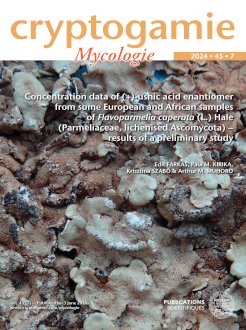The usnic acid, cortical pigment, is generally known to protect lichens from extreme radiation. According to earlier studies, the parmelioid lichen Flavoparmelia caperata (L.) Hale contains (+)-usnic acid. Since the production of lichen secondary metabolites – like other physiological activities – is influenced by environmental conditions, we assumed that macroclimatic differences in temperature, radiation and humidity in European and African habitats resulted in differences in the concentrations measured in samples of this species from various geographical areas. Therefore, we analysed samples representing populations in Hungary (17), Serbia (three), Kenya (eight) and Tanzania (two). Using a chiral chromatographic method, the presence of (+)-usnic acid was confirmed in thirteen of the aforementioned specimens, with concentrations ranging from 5.08 to 26.43 mg g–1 in European samples (12) and 20.27 mg g–1 in a sample from Kenya. The usnic acid content (mg g–1 dry weight) was measured by HPLC-PDA. The content of usnic acid shows a substantial variation in both continents, ranging from 5.21 to 19.23 mg g–1 in Europe and from 6.15 to 23.54 mg g–1 in Africa. The comparison between continents did not result in significant differences. This result can be explained by the supposedly similar microclimatic conditions of the habitats (within macroclimatically different sites) that are probably consistent with the specific niche requirements of F. caperata.
Concentration de l'énantiomère de l'acide (+)-usnique dans des échantillons européens et africains de Flavoparmelia caperata (L.) Hale (Parmeliaceae, Ascomycota lichénisé) – résultats d'une étude préliminaire.
L'acide usnique, pigment cortical, est généralement connu pour protéger les lichens des radiations extrêmes. Selon des études antérieures, le lichen parmélioïde Flavoparmelia caperata (L.) Hale contient de l'acide (+)-usnique. Étant donné que la production de métabolites secondaires du lichen – tout comme d'autres activités physiologiques – est influencée par les conditions environnementales, nous avons supposé que la température, le rayonnement et l'humidité macroclimatiquement différents dans les habitats européens et africains entraînaient des écarts de teneurs dans les échantillons de cette espèce en provenance de diverses zones géographiques. Par conséquent, nous avons analysé des échantillons collectés dans des populations en Hongrie (17), en Serbie (trois), au Kenya (huit) et en Tanzanie (deux). En utilisant une méthode de chromatographie chirale, la présence d'acide (+)-usnique a été confirmée dans treize des échantillons susmentionnés avec une concentration allant de 5,08 à 26,43 mg g–1 dans des échantillons européens (12) et 20,27 mg g–1 dans un échantillon du Kenya. Cette teneur (mg g–1 poids sec) a été mesurée par HPLC-PDA. La teneur en acide usnique montre une variation substantielle dans les deux continents, allant de 5,21 à 19,23 mg g–1 en Europe et de 6,15 à 23,54 mg g–1 en Afrique. La comparaison entre les continents n'a pas abouti à des différences significatives. Ce résultat peut s'expliquer par les conditions microclimatiques supposées similaires de ces habitats (dans des sites macroclimatiquement différents) et qui sont très probablement compatibles avec les exigences spécifiques de niche de F. caperata.





